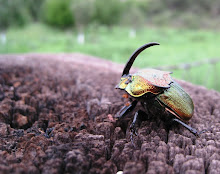I arrived in Quito, Ecuador on August 19th. Ecuador is a small country (about the size of Nevada) bordered to the north by Colombia and to the east and south by Peru (see map of South America below). Despite its small size, Ecuador is diverse in every way, from the variety of habitats you encounter to the biodiversity found within. Ecuador boasts a long coastline running its length, and Darwin's famed Galapagos Islands rest 400 miles off the mainland. Heading from the coast eastward, you climb the western foothills of the Andes Mountains, the longest mountain chain in the world spanning the length of South America. Climbing higher into the Andes, you reach the snow-capped, active volcanoes that create the backbone of this rugged range, and continuing east, the Andes roll down into the eastern foothills, and finally into the Amazon itself.
The biological station where I work rests on the eastern slope of the Andes in cloud forest habitat at 2100m (6,900 ft). The weather systems in Ecuador move from east to west, counter to what we experience in the States. The moisture from the Amazon is picked up in the form of clouds that make their way westward, eventually bumping into the Andes where the roll up and over the mountains creating fog, light rain, and occasionally intense thunderstorms. There is no "dry season" on the east slope of the Andes, just a rainy season and a less rainy season. The forest at this elevation is always wet, so we wear high rubber boots year-round. Temperatures hover around 65 F during the day, but it can seem much colder due to the humidity or much warmer on sunny days.
Here are a series of pictures I took this year and during previous years. The first set of photographs was taken at 2100m in the cloud forest. The first two pictures are of the view from my office window looking east at the Huacamayos Ridge 7 km away. On the other side of the ridge the land drops off into the Amazon basin. Next, a picture of Rain in her usual perch outside my office door. Next, me with a bird called the Beryl-spangled Tanager and the Huacamayos Ridge in the background. I wrote and published my first scientific paper on the nesting biology of this little bird. Finally, a moth that sat outside of my office window for several days last week.
Next, a series of pictures from the eastern foothills (approx. 1200m in elevation). First, me with a giant caecillian, a subterranean, legless amphibian. Very cool, and rare. A picture of the threat display of a potoo taken by a friend, followed by the nestling that the adult potoo was defending. Potoos are nocturnal birds that sit as still as statues during the day on dead tree stumps. They are very hard to spot! Finally, a crazy, wild looking caterpillar we found last year while doing research. Looks like a gummy bear, though probably not as tasty!
The last two photos are from the lowlands (Amazon). The first is me with a muceronid snake that a herpetologist friend found. The last is a giant land snail I photographed while on vacation with my parents at a lowland jungle lodge.



























